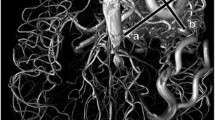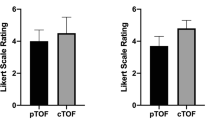Abstract
MR angiography using 3D and 2D time-of-flight techniques were used to evaluate pediatric neurological disorders. MRA (arteriography) and MRV (venography) were abnormal in 63 and 45 cases, respectively. Conventional cerebral angiography was performed in 30 cases. These techniques were compared with MRI and conventional angiography. In addition, the value of MR angiography for surgical planning was subjectively evaluated. Our results showed that intracranial vessels were invariably better showed on MR angiography than on MRI. MRA and MRV were most useful in evaluating vascular distortions related to congenital brain malformations and intracranial tumors. MRA was valuable in detecting arterial narrowing but overestimated the degree of stenosis compared with conventional angiography. MRV was the technique of choice for evaluation of dural sinus and cerebral venous thrombosis and compression. MRA played little to no role in preoperative planning of vascular malformations and aneurysms. It did not appear to be accurate in assessing tumor vascularity or lesions in small arteries and arteritis.
Similar content being viewed by others
References
Masaryk TJ, Modic MT, Ross JS, Ruggieri PM et al (1990) Intracranial circulation; preliminary clinical results with three-dimensional (volume) MR angiography. Radiology 171: 793–799
Edelman RR, Mattle HP, Atkinson DJ, Hoogewoud HM (1990) MR angiography. AJR 154:937–946
Pernicone JR, Thorp KE, Ouimette MV, Siebert JE, Potchen EJ (1992) Magnetic resonance angiography in intracranial vascular disease. Semin Ultrasound CT MRI 13:256–273
Awad IA, McKenzie R et al (1992) Applicationof magnetic resonance angiography to neurosurgical practice: a critical review of 150 cases. Neurol Res 14:360–368
Litt AW, Eldelman EM, Pinto RS, Riles TS et al (1991) Diagnosis of carotid artery stenosis: comparison of 2DFT time of flight MR angiography with contrast angiography in 50 patients. AJNR 12:149–154
Anderson CM, Saloner D, Lee RE, Griswold VJ et al (1992) Assessment of carotid artery stenosis by MR angiography: comparison with X-ray angiography and color-coded Doppler ultrasound. AJNR 13:989–1003
Heiserman JE, Drayer BP, Fram EK, Keller PJ, Bird CR, Hodak JA, Flom RA (1992) Carotid artery stenosis: clinical efficacy of two-dimensional time-of-flight MR angiography. Radiology 182:761–768
Heiserman JE, Drayer BP, Keller PJ, Fram EK (1992) Intracranial vascular stenosis and occlusion: evaluation with three-dimensional time-of-flight MR angiography. Radiology 185: 667–673
Sevick RJ, Tsuruda JS, Schmalbrock P (1990) Three-dimensional time-of-flight MR angiography in the evaluation of cerebral aneurysms. J Comput Assist Tomogr 14:874–881
Ross JS, Masaryk TJ, Modic MT, Ruggieri PM, Haacke EM, Selman WR (1990) Intracranial aneurysm: evaluation by MR angiography. AJNR 11:449–456
Tsuruda JS, Sevick RJ, VanHalbach V (1992) Three-dimensional time-of-flight MR angiography in the evaluation of intracranial aneurysms treated by endovascular balloon occlusion. AJNR 13:1129–1136
Huston III J Lewis BD, Wiebers DO Meyers FB, Riederer SJ, Weaver PAL (1993) Carotid MRA. Carotid artery: prospective blinded comparison of two-dimensional time-of-flight MR angiography with conventional angiography and duplex US. Radiology 186:339–344
Heiserman JE, Burton BP, Fram EK, Keller PJ (1992) MR angiography of cervical fibromuscular dysplasia. AJNR 13: 1454–1457
Bui LN, Brant Zawadzki M, Verghese P, Gillan G (1993) Magnetic resonance angiography of cervicocranial dissection. Stroke 24:126–131
Davis WL (1991) MR angiography of an aberrant internal carotid. AJNR 12:1225
Schuierer G, Laub G, Huk WJ (1990) MR angiography of the primitive trigeminal artery: report of two cases. AJNR 11: 1131–1132
Nussel F, Wegmuller H, Huber P (1991) Comparison of magnetic resonance angiography, magnetic resonance imaging and conventional angiography in cerebral arteriovenous malformation. Neuroradiology 33:56–61
Chen JC, Tsuruda JS, Halbach VV (1992) Suspected dural arteriovenous fistula: results with screening MR angiography in seven patients. Radiology 183: 265–271
Wiznitzer M, Ruggieri PM, Masaryk TJ, Ross JS, Modic MT, Berman B (1990) Diagnosis of cerebrovascular disease in sickle cell anemia by magnetic resonance angiography. J Pediatr 117:551–555
Zimmerman RA, Bogdan AR, Gusnard DA (1992) Pediatric magnetic resonance angiography: assessment of stroke. Cardiovasc Intervent Radiol 15: 60–64
Chakeres DW, Schmalbrock P, Brogan M, Yuan C, Cohen L (1991) Normal venous anatomy of the brain: demonstration with gadopentate dimeglumine in enhanced 3-D MR angiography. AJNR 11: 1107–1118
Rippe DJ, Boyko OB, Spritzer CE, Meisler WJ, Dumoulin CL, Souza SP, Heinz ER (1990) Demonstration of dural sinus occlusion by the use of MR angiography. AJNR 11: 199–201
Listerud J (1991) First principles of magnetic resonance angiography. Magn Reson Q 7: 136–170
Chien D, Edelman RR (1992) Basic principles and clinical applications of magnetic resonance angiography. Semin Roentgenol 1: 53–62
Siebert JE, Pernicone JR, Potchen EJ (1992) Physical principles and application of magnetic resonance angiography. Semin Ultrasound CT MRI 13: 227–245.
Anderson CM, Haacke EM (1992) Approaches to diagnostic magnetic resonance carotid angiography. Semin Ultrasound CT MRI 13: 246–255
Lenz GW, Haacke EM, Masaryk TJ, Laub G (1988) In plane vascular imaging: pulse sequence design and strategy. Radiology 166: 875–882
Lewin JS, Laub G (1991) Intracranial MR angiography: a direct comparison of three time-of-flight techniques. AJNR 12: 1133–1139
Li W, Kramer J, Kleefield J, Edelman RR (1992) MR angiography of the extracranial carotid arteries using a two-slab oblique 3D acquisition. AJNR 13: 1423–1428
Ruggier PM, Laub GA, Masaryk TJ, Modic MT (1989) Intracranial circulation: pulse sequence considerations in three-dimensional (volume) MR angiography. Radiology 171: 785–791
Tsuruda J, Saloner D, Norman D (1992) Artifacts associated with MR neuroangiography. AJNR 13: 1411–1422
Purdy D, Geneva C, Laub G (1992) The design of variable tip angle slab selection (TONE) pulses for improved 3D MR angiography. Abstract, SMRM Annual Scientic Meeting 1: 882
Schmalbrock P, Yuan C, Chakeres DW, Kohli J, Pelc NJ (1990) Volume MR angiography: methods to achieve very short echo times. Radiology 175: 861–865
Edelman RR, Sungkee SA, Chien A, Li W et al (1992) Improved time-of-flight MR angiography of the brain with magnetization transfer contrast. Radiology 184: 395–399
Brown DG, Riederer SJ (1992) Contrast-to-noise ratios in maximum intensity projection images. Magn Reson Med 23: 130–137
Pernicone JR, Siebert JE, Potchen EJ (1990) Demonstration of an early draining vein by MR angiography. J Comput Assist Tomogr 18: 829–831
Author information
Authors and Affiliations
Rights and permissions
About this article
Cite this article
Lee, B.C.P., Park, T.S. & Kaufman, B.A. MR angiography in pediatric neurological disorders. Pediatr Radiol 25, 409–419 (1995). https://doi.org/10.1007/BF02019052
Received:
Accepted:
Issue Date:
DOI: https://doi.org/10.1007/BF02019052




